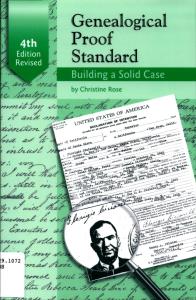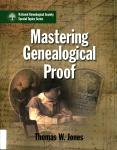 When we start our family tree, the going is usually smooth. Ancestors fall into line without too much trouble because we are familiar with them or have heard of them. By personal knowledge, we know who belongs in our tree…or so we think.
When we start our family tree, the going is usually smooth. Ancestors fall into line without too much trouble because we are familiar with them or have heard of them. By personal knowledge, we know who belongs in our tree…or so we think.
As we journey farther back in time, relationships become less clear. How do we know whether this Adam Smith is the one who married our great-great grandmother Jane Doe? We dig and gather, gather and dig, but no “smoking gun” appears to make the relationship evident.
Then we may go back, look at our previous research, and start to question the earlier assumptions we made. Does that census record conclusively show that Grandpa Joe had four brothers and no sisters? Why does Dad’s cousin have different names in different records?
The best way to make sure that our genealogy conclusions are free of error is to apply the highest standard to our research: the Genealogical Proof Standard.
The Genealogical Proof Standard (also known as GPS) is a five-point process developed by the Board for Certification of Genealogists to help genealogists build a solid case for a conclusion to a genealogy puzzle. It gives us steps for analyzing our sources and our thought processes; it helps resolve conflicts.
The Genealogical Proof Standard contains these five components:
- Reasonably exhaustive research—emphasizing original records providing participants’ information—for all evidence that might answer a genealogist’s question about an identity, relationship, event or situation.
- Complete, accurate citations to the source or sources of each information item contribution—directly, indirectly, or negatively—to answers about that identity, relationship, event, or situation.
- Tests—through processes of analysis and correlation—of all sources, information items, and evidence contributing to an answer to a genealogical question or problem.
- Resolution of conflicts among evidence items pertaining to the proposed answer.
- A soundly reasoned, coherently written conclusion based on the strongest available evidence.
If all this sounds overwhelming, never fear.
Cook Library has several books that will help make the GPS easy to understand and apply. Check out the books below and use the information therein to scrutinize your sources and conclusions. You will be much more confident in your research when you have applied these standards, and your confidence in your genealogy skills will grow as well.
Happy analyzing!
Genealogical Proof Standard, Building A Solid Case by Christine Rose. San Jose, California: CR Publications, 2014, 4th edition, revised. Defines and explains all terms and concepts, with case studies at the end.
Genealogy Standards, Board for Certification of Genealogists. Washington, D.C.: Ancestry, 2014, 50th Anniversary Edition. Discusses the Genealogical Proof Standard in the first few pages and the rest of the book is devoted to outlining standards for other areas of genealogy: documenting, researching, writing, for genealogical educators, and continuing education.
Mastering Genealogical Proof by Thomas W. Jones, Arlington, Virginia: National Genealogical Society, 2013. Covers everything in Ms. Rose’s book but in more depth, written as a workbook with exercises.
Categories: Genealogy
Tags: Genealogy



